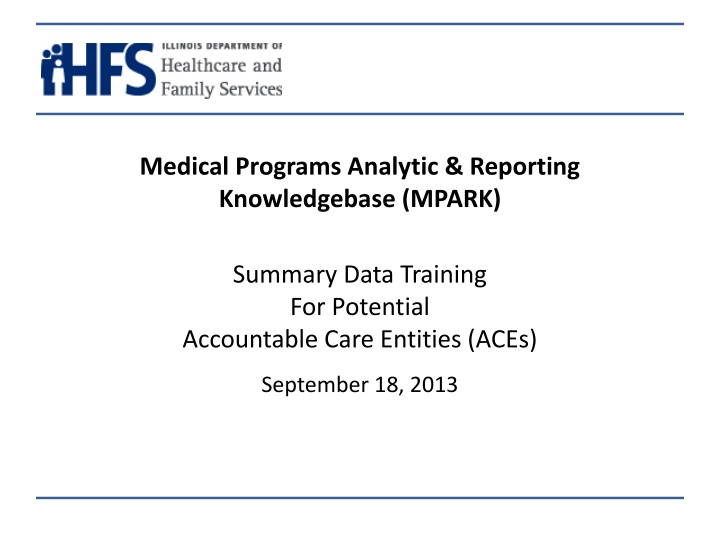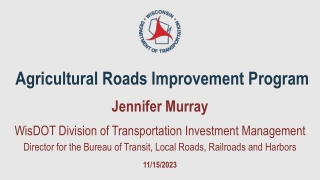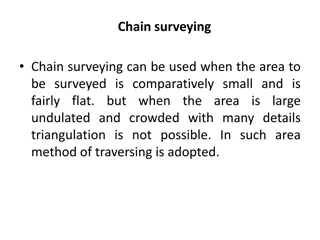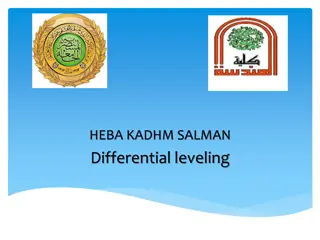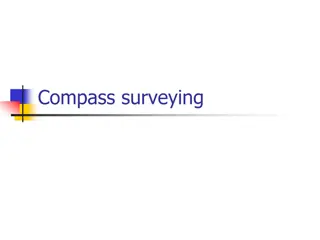Agricultural Engineering Practices: Surveying Techniques and Equipment
In this lecture on agricultural engineering practices, Miss Media Nofel M. Fawzi discusses different types of surveying techniques and equipment such as chain surveying and leveling. The presentation covers the use of water levels, optical levels, and laser levels in agricultural surveying work. Detailed instructions on using a water level on the field are provided, along with insights into survey accuracy and methodology. This informative session aims to enhance understanding of surveying methodologies in agricultural engineering.
Download Presentation

Please find below an Image/Link to download the presentation.
The content on the website is provided AS IS for your information and personal use only. It may not be sold, licensed, or shared on other websites without obtaining consent from the author.If you encounter any issues during the download, it is possible that the publisher has removed the file from their server.
You are allowed to download the files provided on this website for personal or commercial use, subject to the condition that they are used lawfully. All files are the property of their respective owners.
The content on the website is provided AS IS for your information and personal use only. It may not be sold, licensed, or shared on other websites without obtaining consent from the author.
E N D
Presentation Transcript
Medical Programs Analytic & Reporting Knowledgebase (MPARK) Summary Data Training For Potential Accountable Care Entities (ACEs) September 18, 2013
Prepared by Tia Goss Sawhney DrPH, FSA Director of Data, Analytics, and Research Tia.sawhney@illinois.gov September 18, 2013 HFS: ACE Summary Data Training 2
What Data Topical summary data with respect to Recipients Providers Hospital admissions Prescription drugs Emergency room visits By service calendar year 2010 and 2011 September 18, 2013 HFS: ACE Summary Data Training 3
How Presented One (large) table for each topical area 5 tables One row for each entity within a topical area Your data will include ACE eligible recipients, their services, and the providers that provided those services About 75% of statewide Medicaid recipients You can request a narrower geographic selection +Recipient-Provider cross-walk table Connects service and cost columns of Recipient and Provider tables September 18, 2013 HFS: ACE Summary Data Training 4
How Delivered Data tables: by secure file transfer (ftp) After completion of data use agreement Link sent via email and expires after 5 days(!) Zipped -- you will be provided instructions for unzipping Comma delimited with character fields in quotes Reference tables: DRG1995, Diagnosis, ICD-9 Procedure Codes Available on MPARK website September 18, 2013 HFS: ACE Summary Data Training 5
Metadata This presentation Data dictionary Describes each table and column Glossary Terms used in data dictionary or within the data Acronym list CDPS condition flag documentation Sample SQL analysis code, with annotation Submit questions September 18, 2013 HFS: ACE Summary Data Training 6
Why Not Claims Level Data? Much easier to use (!!!!!!!) This is what we use for innovation analysis Data is flattened and simplified No need for reference tables Smaller Requires substantially less IT infrastructure HIPAA limited data set Less onerous data management requirements September 18, 2013 HFS: ACE Summary Data Training 7
Use The Data To Understand population enrollment and demographic characteristics Understand which providers provide care for a population Understand population costs Assess the population potential for care coordination The go to data for coordinated care strategy development September 18, 2013 HFS: ACE Summary Data Training 8
Not For Recent data Coordinating the care of a specific recipient Quality of care measurements Longitudinal analysis other than year-to-year ACA expansion population September 18, 2013 HFS: ACE Summary Data Training 9
ACE Data Potential ACEs receive data for about 75% of Medicaid recipients ACE Eligible Population Includes: Recipients currently enrolled in voluntary HMOs See section 3.1.3.6 of solicitation for exclusions Mostly healthy children and adults Non-disabled, non-senior Less than 75% of Admissions, Drugs, and ER Visits No waiver services or waiver providers Row counts on the following pages are for 100% of Medicaid recipients September 18, 2013 HFS: ACE Summary Data Training 10
Recipient Table Primary Key: RecipientKeyID Columns: Demographics and enrollment (40) Age / sex / race / ethnicity / county/ zip / Medicare / PCCM / PCP / MCO / disabled / CCE elig / days Diagnosis and drugs (110) SMI / CDPS Dx / CDPS Rx Waiver participation (30) Services Used indicators (60) / events (60) / units (60) / costs (60) / add-on cost (1) / total cost (1) Size (statewide, 1 yr): ~3.0 million rows, ~420 columns September 18, 2013 HFS: ACE Summary Data Training 11
Provider Table Primary Key: ProviderKeyID Columns: Provider description (10) Provider type / name / county /zip / NPI (when available) / reimbursement type Services Recipients served (60) / events (60) / units (60) / costs (60) / add- on cost (1) / total cost (1) Can use cross-walk table to recreate for sub-populations Size (statewide, 1 yr): ~100k rows, ~250 columns September 18, 2013 HFS: ACE Summary Data Training 12
Types of Service (Recipient and Provider File) Inpatient hospital*: IPMatDelv + ERUndocAlienCost + IPMatNonDelv + IPNewborn + IPSubAbuse+ IPPsych + IPOther Claim costs only, inclusive of DSH and related payments Nursing homes (non-DD): NursingFacility + Hospice DD institutions: ICFMRPrivate + ICFMRPublic State mental hospitals: MentalHealthRegCost Prescription drugs*: PrescDrugs Emergency room*: ER September 18, 2013 HFS: ACE Summary Data Training 13
Types of Service, contd Waiver services: HCBSRH + HCBSPC + HCBSDH + HCBSHM + HCBSOS + HCBSSE + HCBSCM + HCBSADH + HCBSHHA + HCBSRespite + HCBSESPS + HCBSPVS Professional: PhysSurgReg + Outpatient + ClinicServices + FQHC + RHC + FQHCRHCMH + PCCM + EPSDT Note: FQHC and RHC include all services provided at those sites, including non-professional lab and radiology Mental health and substance abuse rehab: RehabMH + RehabSA Managed care (non-PCCM) MedHIPPMCO + HospEncounterAddOn Note: substantial costs have historically been excluded from our voluntary HMO contracts, including prescription drugs Lab/radiology: LabRadiology September 18, 2013 HFS: ACE Summary Data Training 14
Types of Service, contd Non-emergency transport: NonERMedTransCost Other OtherServices + TCM + DentalServices + PDDE + OtherPracServ +PvtDutyNursing + SchoolBased + Nurses + SHL + PhysicalTherapy + OccTherapy + RehabOther + Sterl + Abortion + HomeHealth + Admin + CoinsurDeduct + PHP Notes: * Event-level details available via separate tables Types of service were developed from federal reporting requirements A cost that is small overall may be very significant for a particular population September 18, 2013 HFS: ACE Summary Data Training 15
Recipient-Provider Cross-Walk Table Primary Key: RecipientKeyID & ProviderKeyID & TypeofService Columns: Events (1) / Units (1) / Cost (1) Size (statewide, 1 yr): ~30 million rows, 6 columns Useful for: Identifying populations served by select providers Identifying providers serving select populations September 18, 2013 HFS: ACE Summary Data Training 16
Hospital Admission Table Primary Key: RecipientKeyID & AdmissionSeqNbr RecipientKeyID & AdmissionDt & ProviderKeyID is close to but not a key Modeled from IL Hospital Discharge Database (IHA/IDPH) Columns: Admission (15) Recipient / hospital / dates / admission source & type / discharge status / type of service Diagnoses Codes (25) / POA indicators (25) Procedures Codes (25) / dates (25) Financial (35) DRG / Charge / other payers / payment by component Size (statewide, 1 yr): ~ 500k rows, ~ 150 columns September 18, 2013 HFS: ACE Summary Data Training 17
Emergency Room Table Primary Key: RecipientKeyID & AdmissionSeqNbr RecipientKeyID & AdmissionDt & ProviderKeyID is close to but not a key Modeled from IL Hospital Discharge Database (IHA/IDPH) Columns: Admission (15) Recipient / hospital / dates / admission source & type / discharge status / type of service Diagnoses Codes (25) / POA indicators (25) Financial (35) APLGroup (the payment basis for ER visits) / Charge / other payers / payment by component Size (statewide, 1 yr): ~ 2 million rows, ~ 100 columns September 18, 2013 HFS: ACE Summary Data Training 18
Drug Detail Table Primary Key: RecipientKeyID & ClaimSeqNbr Columns: Drug (20) NDC / name/ generic / dose / days / pharmacy / prescribing doc / class (not ideally expressed) Financial (5) CDPS indicators (45) Size (statewide, 1 yr): ~ 26 million rows, ~ 70 columns September 18, 2013 HFS: ACE Summary Data Training 19
Fee For Service (FFS) vs. Managed Care Organization (MCO) Data Services paid for by MCOs are NOT included in data Excluded services paid FFS and are included in the data The MCO contracts for potential ACE recipients, until recently, excluded prescription drugs and several other types of service MCO premiums are included (TOS=MedHIPPMCO), inclusive of maternity kick payments Extra payments to FQHCs and Hospitals (TOS= HospEncounterAddOnPayment) are included To understand FFS costs, exclude recipients who had MCO coverage during year September 18, 2013 HFS: ACE Summary Data Training 20
Request Data Statewide Big Have all data for to consideration various geographies *Or* Subset Only You define your geography of interest Smaller and easier to manage September 18, 2013 HFS: ACE Summary Data Training 21
Caveats HIPAA limited data set Cannot attempt to identify Only named users for intended purposes Requires database software and skills Excel not adequate except for smaller subpopulations Summary data can be no better than source data Messy around edges Flattening introduces issues Must read metadata (!!!) Learning process for us Questions and feedback, negative and positive, welcomed September 18, 2013 HFS: ACE Summary Data Training 22
Strategy Development At the highest level Identify your population Identify the costs associated with the population by type of service Determine which costs for which type of service are reducible and by how much Refer to literature Determine which costs may increase and the resulting net savings Develop plan for: Net claims savings >= care coordination fee >= ACE costs to deliver care coordination Organize ACE to achieve savings September 18, 2013 HFS: ACE Summary Data Training 23
Strategy Considerations Phase-in period Sub-populations Proportion of care with affiliated providers Medical management literature High vs. impactable costs Acute care outliers / end of life care Risk stratification / targeted efforts Regression to the mean Statistical variation September 18, 2013 HFS: ACE Summary Data Training 24
Sample Population Criteria ( where statements) Serious Mental Illness Condition SMIInd=1 Enrolled as of point in time (end of year) CurrentEnrollmentInd=1 Adult AgeGrpCd>=2 Not in MCO anytime during year MCOInd=0 In certain counties: Countydesc IN ( XXX', YYY ) Note: Be careful with county spellings (Mc, St, and De counties; Will and Williamson) September 18, 2013 HFS: ACE Summary Data Training 25
Calculating Population Average Cost Monthly cost (PMPM) (365/12)*SUM(Cost)/SUM(NbrOfEnrolledDays) Annualized cost 365*SUM(Cost)/SUM(NbrOfEnrolledDays) September 18, 2013 HFS: ACE Summary Data Training 26
Combining Years Use outer join on primary key for Recipient and Provider Unless your goal is to only select recipients or providers present in each year Append hospital and prescription drug files September 18, 2013 HFS: ACE Summary Data Training 27
Resources Metadata: ACE data website: http://www2.illinois.gov/hfs/PublicInvolvement/cc/ACE/Pages/ Data.aspx Always start with the website and the metadata it provides Questions, including to add another data user to the data use agreement: Paul.stieber@illinois.gov Outbound communication: For critical or time-sensitive matters Make sure that we have accurate contact information for Primary ACE contact Primary data contact, if different September 18, 2013 HFS: ACE Summary Data Training 28
